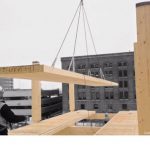Brief
Modular construction is becoming increasingly popular in California for constructing affordable housing for the homeless due to the time and cost savings it provides. Despite some challenges, such as logistics and community resistance, it is likely to continue to play an important role in the construction industry.
Insight
Modular construction is increasingly being used to build affordable housing for the homeless in California due to its speed and cost-effectiveness. This method involves constructing individual units in a factory and then transporting them to the construction site for assembly, which significantly reduces the construction timeline.
In San Francisco, the modular construction of a housing project for the homeless was completed in just over a year, compared to the 2-3 years it would have taken using traditional construction methods. In addition to being faster, modular construction can also be more cost-effective as it allows for bulk purchasing of materials and can reduce the amount of waste produced during the construction process.
The use of modular construction for affordable housing has become increasingly popular due to the rising costs of traditional construction methods, as well as a shortage of skilled labor in the construction industry. Additionally, modular construction can also provide greater flexibility in design and can be customized to meet the unique needs of a specific community.
Despite its advantages, modular construction still faces some challenges. There can be logistical issues with transportation and assembly of the units, and the quality of the final product can vary depending on the factory and construction team. Additionally, there can be resistance from local communities who may view the units as unsightly or not in keeping with the neighborhood’s aesthetic.
Overall, the use of modular construction for affordable housing is a promising development for California’s homeless population. As the construction industry continues to evolve, it is likely that modular construction will play an increasingly important role in providing housing solutions for those in need.
Keyword 360
Modular Construction
Related Questions:
-
What are the disadvantages of modular construction?
-
What is the benefit of modular construction?
-
What is modular construction made of?
-
Is modular construction the future?
Related Refrences:
1.Modular Building Institute (MBI) Guide to Modular Construction
This comprehensive guidebook is the industry standard for modular construction, covering everything from design and engineering to manufacturing, transportation, and installation.
2.”Offsite Construction: Opportunities and Challenges” Report by the Offsite Construction Council (OSCC)
This report provides an overview of the offsite construction industry, including modular construction, and discusses the challenges and opportunities for the industry.
3.2021 International Building Code (IBC) by the International Code Council (ICC)
The most recent version of the IBC includes updated requirements for modular construction, including new provisions for modular multi-story buildings and modular commercial kitchens.
4.”Modular Construction: From Projects to Products” Report by the UK Government’s Construction Leadership Council
This report explores the potential benefits of modular construction, including increased productivity and sustainability, and provides recommendations for promoting the use of modular construction in the UK.
Related Challenges:
1. Transportation logistics: Modular construction involves building components in a factory and transporting them to the construction site for assembly. This requires careful planning and coordination to ensure that the modules are delivered on time and that there is sufficient space and access for installation.
2.Limited design flexibility: Modular construction requires a more standardized design approach, which can limit the level of customization and design flexibility that is possible. This may be a challenge for projects that require unique architectural features or complex building systems.
3.Quality control: While modular construction can improve quality control by allowing for more standardized building processes and factory-based inspections, it also requires a high degree of precision and accuracy to ensure that all modules fit together seamlessly. Any errors in the manufacturing or transportation process can result in delays and additional costs.
4.Skilled labor shortage: Modular construction requires a different set of skills and expertise than traditional construction, which can create a challenge for finding and training skilled labor. Additionally, the perception of modular construction as less prestigious or less skilled than traditional construction can create recruitment challenges.
5.Upfront investment costs: Modular construction often requires a higher upfront investment in factory facilities and equipment than traditional construction, which can be a barrier to entry for smaller companies or start-ups. However, this can be offset by the potential cost savings and increased efficiency that comes with the standardized manufacturing process.






Recent Comments